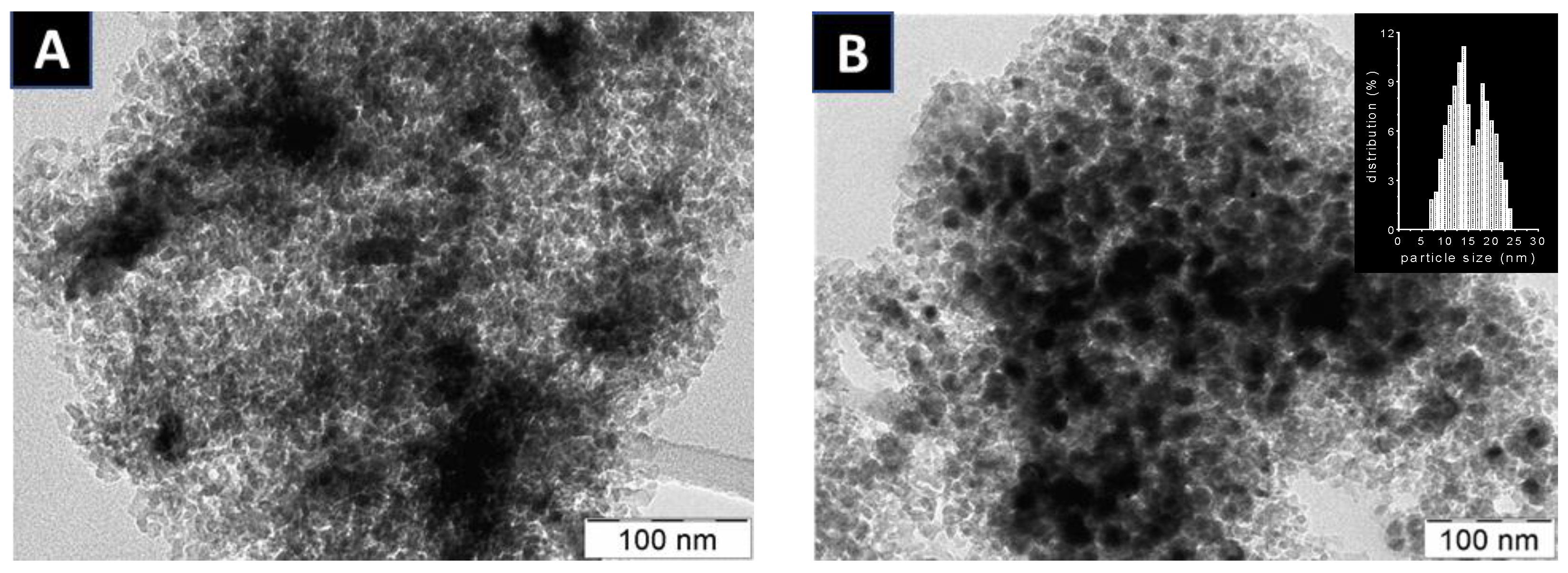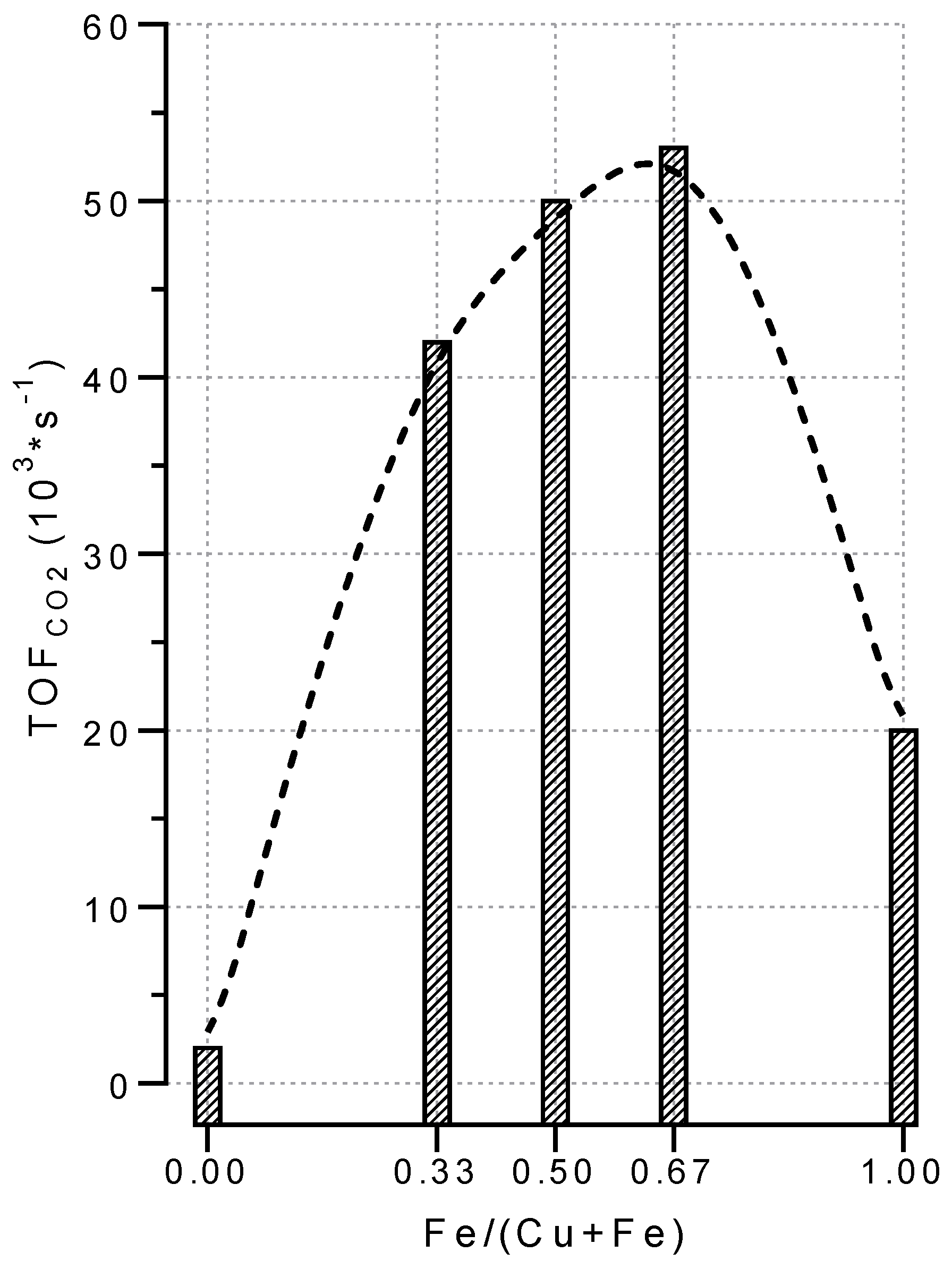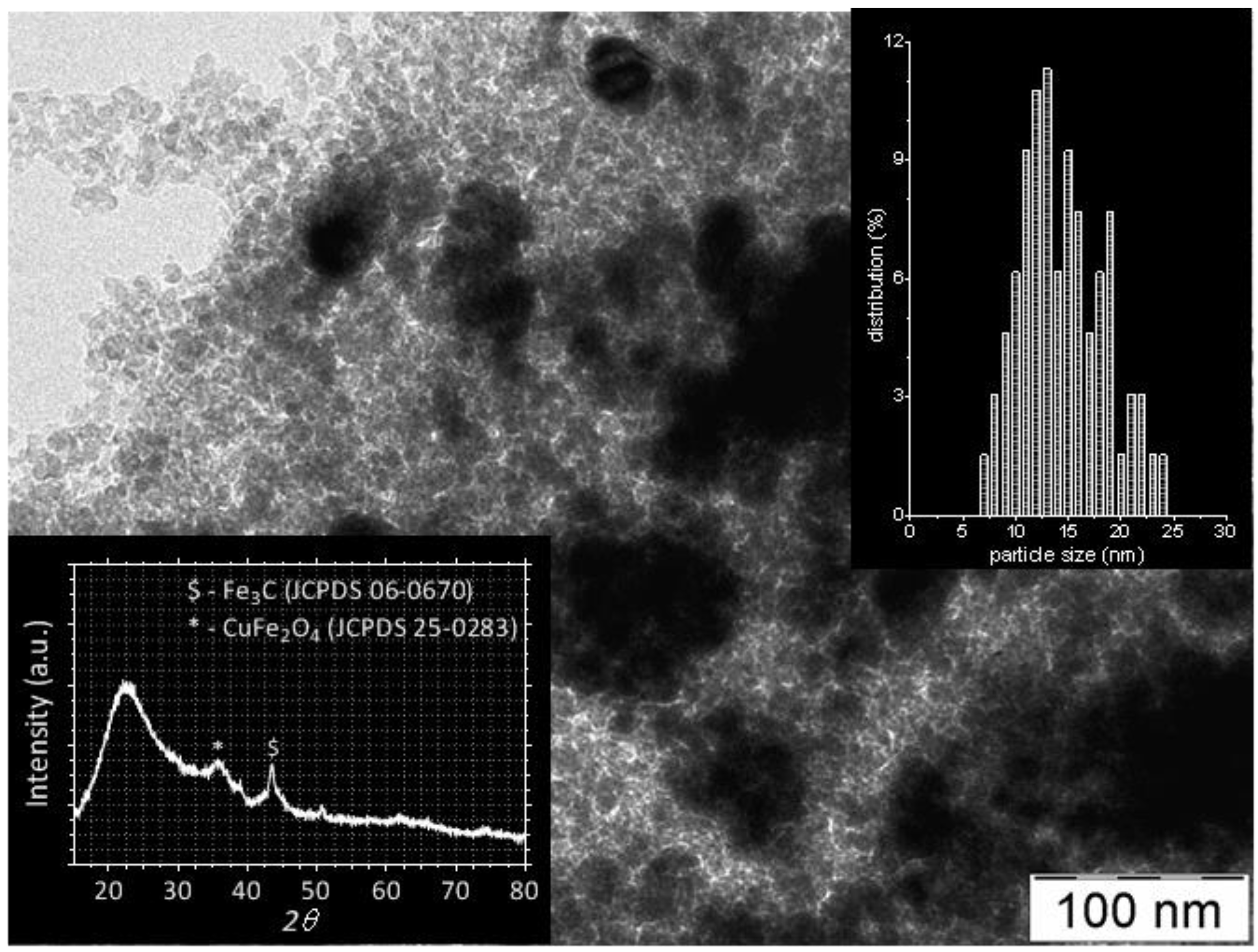Copper and Iron Cooperation on Micro-Spherical Silica during Methanol Synthesis via CO2 Hydrogenation
Abstract
:1. Introduction
2. Results and Discussion
3. Materials and Methods
3.1. Catalyst Preparation
3.2. Characterization
3.3. Testing
4. Conclusions
Supplementary Materials
Author Contributions
Funding
Data Availability Statement
Acknowledgments
Conflicts of Interest
References
- Yoro, K.O.; Daramola, M.O. Advances in Carbon Capture; Rahimpour, M.R., Farsi, M., Makarem, M.A., Eds.; Woodhead Publishing: Cambridge, UK, 2020; pp. 3–28. [Google Scholar]
- Kenarsari, S.D.; Yang, D.; Jiang, G.; Zhang, S.; Wang, J.; Russell, A.G.; Wei, Q.; Fan, M. Review of recent advances in carbon dioxide separation and capture. RSC Adv. 2013, 3, 22739–22773. [Google Scholar] [CrossRef]
- Fawzy, S.; Osman, A.I.; Doran, J.; Rooney, D.W. Strategies for mitigation of climate change: A review. Environ. Chem. Lett. 2020, 18, 2069–2094. [Google Scholar] [CrossRef]
- Meylan, F.D.; Moreau, V.; Erkman, S. CO2 utilization in the perspective of industrial ecology, an overview. J. CO2 Util. 2015, 12, 101–108. [Google Scholar] [CrossRef]
- Zhang, Z.; Wang, T.; Blunt, M.J.; Anthony, E.J.; Park, A.A.; Hughes, R.W.; Webley, P.A.; Yan, J. Advances in carbon capture, utilization and storage. Appl. Energy 2020, 278, 115627–115680. [Google Scholar] [CrossRef]
- Nocito, F.; Dibenedetto, A. Atmospheric CO2 mitigation technologies: Carbon capture utilization and storage. Curr. Opin. Green Sustain. Chem. 2020, 21, 34–43. [Google Scholar] [CrossRef]
- Markewitz, P.; Kuckshinrichs, W.; Leitner, W.; Linssen, J.; Zapp, P.; Bongartz, R.; Schreiber, A.; Müller, T. Worldwide innovations in the development of carbon capture technologies and the utilization of CO2. Energy Environ. Sci. 2012, 5, 7281–7305. [Google Scholar] [CrossRef] [Green Version]
- Soltanieh, M.; Mahmoodi Azar, K.; Saber, M. Development of a zero emission integrated system for co-production of electricity and methanol through renewable hydrogen and CO2 capture. Int. J. Greenh. 2012, 7, 145–152. [Google Scholar] [CrossRef]
- Hos, T.; Landau, M.V.; Herskowitz, M. Hydrogenation of CO2 on Fe-Based Catalysts: Preferred Route to Renewable Liquid Fuels. Eng. Chem. Res. 2022, in press. [Google Scholar] [CrossRef]
- Matzen, M.; Demirel, Y. Methanol and dimethyl ether from renewable hydrogen and carbon dioxide: Alternative fuels production and life-cycle assessment. J. Clean. Prod. 2016, 139, 1068–1077. [Google Scholar] [CrossRef] [Green Version]
- Catizzone, E.; Freda, C.; Braccio, G.; Frusteri, F.; Bonura, G. Dimethyl ether as circular hydrogen carrier: Catalytic aspects of hydrogenation/dehydrogenation steps. J. Energy Chem. 2021, 58, 55–77. [Google Scholar] [CrossRef]
- Atsbha, T.A.; Yoon, T.; Seongho, P.; Lee, C.J. A review on the catalytic conversion of CO2 using H2 for synthesis of CO, methanol, and hydrocarbons. J. CO2 Util. 2021, 44, 101413–101435. [Google Scholar] [CrossRef]
- Wang, J.; Zhang, G.; Zhu, J.; Zhang, X.; Ding, F.; Zhang, A.; Guo, X.; Song, C. CO2 Hydrogenation to Methanol over In2O3-Based Catalysts: From Mechanism to Catalyst Development. ACS Catal. 2021, 11, 1406–1423. [Google Scholar] [CrossRef]
- Schorn, F.; Breuer, J.L.; Samsun, R.C.; Schnorbus, T.; Heuser, B.; Peters, R.; Stolten, D. Methanol as a renewable energy carrier: An assessment of production and transportation costs for selected global locations. Adv. Appl. Energy 2021, 3, 100050–100064. [Google Scholar] [CrossRef]
- Dalena, F.; Senatore, A.; Basile, M.; Knani, S.; Basile, A.; Iulianelli, A. Advances in Methanol Production and Utilization, with Particular Emphasis toward Hydrogen Generation via Membrane Reactor Technology. Membranes 2018, 8, 98. [Google Scholar] [CrossRef] [PubMed] [Green Version]
- Müller, K.; Fabisch, F.; Artl, W. Energy Transport and Storage using Methanol as a Carrier. Green 2014, 4, 19–25. [Google Scholar] [CrossRef]
- Meunier, N.; Chauvy, R.; Mouhoubi, S.; Thomas, D.; De Weireld, G. Alternative production of methanol from industrial CO2. Renew. Energy 2020, 146, 1192–1203. [Google Scholar] [CrossRef]
- Marlin, D.S.; Sarron, E.; Sigurbjörnsson, O. Process Advantages of Direct CO2 to Methanol Synthesis. Front. Chem. 2018, 6, 446–454. [Google Scholar] [CrossRef]
- Pérez-Fortes, M.; Schöneberger, J.C.; Boulamanti, A.; Tzimas, E. Methanol synthesis using captured CO2 as raw material: Techno-economic and environmental assessment. Appl. Energy 2016, 161, 718–732. [Google Scholar] [CrossRef]
- Bowker, M. Methanol Synthesis from CO2 Hydrogenation. ChemCatChem 2019, 11, 4238–4246. [Google Scholar] [CrossRef] [Green Version]
- Chauvy, R.; De Weireld, G. CO2 Utilization Technologies in Europe: A Short Review. Energy Technol. 2020, 8, 2000627–2000644. [Google Scholar] [CrossRef]
- Guil-López, R.; Mota, N.; Llorente, J.; Millán, E.; Pawelec, B.; Fierro, J.L.G.; Navarro, R.M. Methanol Synthesis from CO2: A Review of the Latest Developments in Heterogeneous Catalysis. Materials 2019, 12, 3902. [Google Scholar] [CrossRef] [PubMed] [Green Version]
- Kleiber, S.; Pallua, M.; Siebenhofer, M.; Lux, S. Catalytic Hydrogenation of CO2 to Methanol over Cu/MgO Catalysts in a Semi-Continuous Reactor. Energies 2021, 14, 4319. [Google Scholar] [CrossRef]
- Wu, Q.; Liang, S.; Zhang, T.; Louis, B.; Wang, Q. Hydrogen-rich syngas production from biomass pyrolysis and catalytic reforming using biochar-based catalysts. Fuel 2022, 313, 123006–123016. [Google Scholar] [CrossRef]
- Leonzio, G.; Zondervan, E.; Foscolo, P.U. Methanol production by CO2 hydrogenation: Analysis and simulation of reactor performance. Int. J. Hydrog. Energy 2019, 44, 7915–7933. [Google Scholar] [CrossRef]
- Kanuri, S.; Roy, S.; Chakraborty, C.; Datta, S.P.; Singh, S.A.; Dinda, S. An insight of CO2 hydrogenation to methanol synthesis: Thermodynamics, catalysts, operating parameters, and reaction mechanism. Int. J. Energy Res. 2022, 4, 5503–5522. [Google Scholar] [CrossRef]
- Arena, F.; Barbera, K.; Italiano, G.; Bonura, G.; Spadaro, L.; Frusteri, F. Synthesis, characterization and activity pattern of Cu–ZnO/ZrO2 catalysts in the hydrogenation of carbon dioxide to methanol. J. Catal. 2007, 249, 185–194. [Google Scholar] [CrossRef]
- Arena, F.; Italiano, G.; Barbera, K.; Bordiga, S.; Bonura, G.; Spadaro, L.; Frusteri, F. Solid-state interactions, adsorption sites and functionality of Cu-ZnO/ZrO2 catalysts in the CO2 hydrogenation to CH3OH. Appl. Catal. A Gen. 2008, 350, 16–23. [Google Scholar] [CrossRef]
- Bonura, G.; Cordaro, M.; Cannilla, C.; Arena, F.; Frusteri, F. The changing nature of the active site of Cu-Zn-Zr catalysts for the CO2 hydrogenation reaction to methanol. Appl. Catal. B Environ. 2014, 152, 152–161. [Google Scholar] [CrossRef]
- Ding, M.; Qiu, M.; Wang, T.; Ma, L.; Wu, C.; Liu, J. Effect of iron promoter on structure and performance of CuMnZnO catalyst for higher alcohols synthesis. Appl. Energy 2012, 97, 543–547. [Google Scholar] [CrossRef]
- Guo, H.; Zhang, H.; Peng, F.; Yang, H.; Xiong, L.; Wang, C.; Huang, C.; Chen, X.; Ma, L. Effects of Cu/Fe ratio on structure and performance of attapulgite supported CuFeCo-based catalyst for mixed alcohols synthesis from syngas. Appl. Catal. A Gen. 2015, 503, 51–61. [Google Scholar] [CrossRef]
- Xu, D.; Ding, M.; Hong, X.; Liu, G.; Tsang, S.C.E. Selective C2+ Alcohol Synthesis from Direct CO2 Hydrogenation over a Cs-Promoted Cu-Fe-Zn Catalyst. ACS Catal. 2020, 10, 5250–5260. [Google Scholar] [CrossRef]
- Chen, C.-S.; Cheng, W.-H.; Lin, S.-S. Study of iron-promoted Cu/SiO2 catalyst on high temperature reverse water gas shift reaction. Appl. Catal. A Gen. 2004, 257, 97–106. [Google Scholar] [CrossRef]
- Xiao, K.; Bao, Z.; Qi, X.; Wang, X.; Zhong, L.; Lin, M.; Fang, K.; Sun, Y. Unsupported CuFe bimetallic nanoparticles for higher alcohol synthesis via syngas. Catal. Commun. 2013, 40, 154–157. [Google Scholar] [CrossRef] [Green Version]
- Lu, Y.; Yu, F.; Hu, J.; Liu, J. Catalytic conversion of syngas to mixed alcohols over Zn-Mn promoted Cu-Fe based catalyst. Appl. Catal. A Gen. 2012, 429, 48–58. [Google Scholar] [CrossRef]
- Gao, W.; Zhao, Y.; Liu, J.; Huang, Q.; He, S.; Li, C.; Zhao, J.; Wei, M. Catalytic conversion of syngas to mixed alcohols over CuFe-based catalysts derived from layered double hydroxides. Catal. Sci. Technol. 2013, 3, 1324–1332. [Google Scholar] [CrossRef]
- Strekalova, A.A.; Shesterkina, A.A.; Kustov, L.M. Recent progress in hydrogenation of esters on heterogeneous bimetallic catalysts. Catal. Sci. Technol. 2021, 22, 7229–7238. [Google Scholar] [CrossRef]
- Chen, K.; Yu, J.; Liu, B.; Si, C.; Ban, H.; Cai, W.; Li, C.; Li, Z.; Fujimoto, K. Simple strategy synthesizing stable CuZnO/SiO2 methanol synthesis catalyst. J. Catal. 2019, 372, 163–173. [Google Scholar] [CrossRef]
- Yang, H.; Gao, P.; Zhang, C.; Zhong, L.; Li, X.; Wang, S.; Wang, H.; Wei, W.; Sun, Y. Core–shell structured Cu@m-SiO2 and Cu/ZnO@m-SiO2 catalysts for methanol synthesis from CO2 hydrogenation. Catal. Commun. 2016, 84, 56–60. [Google Scholar] [CrossRef]
- Ren, S.; Shoemaker, W.R.; Wang, X.; Shang, Z.; Klinghoffer, N.; Li, S.; Yu, M.; He, X.; White, T.A.; Liang, X. Effects of mixing methods of bifunctional catalysts on catalyst stability of DME synthesis via CO2 hydrogenation. Fuel 2019, 239, 1125–1133. [Google Scholar] [CrossRef]
- Kattel, S.; Ramìrez, P.J.; Chen, J.G.; Rodriguez, J.A.; Liu, P. Active sites for CO2 hydrogenation to methanol on Cu/ZnO catalysts. Science 2017, 355, 1296–1299. [Google Scholar] [CrossRef] [Green Version]
- Cui, X.; Yan, W.; Yang, H.; Shi, Y.; Xue, Y.; Zhang, H.; Niu, Y.; Fan, W.; Deng, T. Preserving the Active Cu–ZnO Interface for Selective Hydrogenation of CO2 to Dimethyl Ether and Methanol. ACS Sustain. Chem. Eng. 2021, 9, 2661–2672. [Google Scholar] [CrossRef]
- Lam, E.; Corral-Pérez, J.J.; Larmier, K.; Noh, G.; Wolf, P.; Comas-Vives, A.; Urakawa, A.; Copéret, C. CO2 Hydrogenation on Cu/Al2O3: Role of the Metal/Support Interface in Driving Activity and Selectivity of a Bifunctional Catalyst. Angew. Chem. Int. Ed. 2019, 58, 13989–13996. [Google Scholar] [CrossRef]
- Frusteri, L.; Cannilla, C.; Todaro, S.; Frusteri, F.; Bonura, G. Tailoring of Hydrotalcite-Derived Cu-Based Catalysts for CO2 Hydrogenation to Methanol. Catalysts 2019, 9, 1058. [Google Scholar] [CrossRef] [Green Version]
- Carvalho, D.F.; Almeida, G.C.; Monteiro, R.S.; Mota, C.J.A. Selective Hydrogenation of CO2 to Hydrocarbons: Effects of Fe3O4 Particle Size on Reduction, Carburization, and Catalytic Performance. Energy Fuels 2020, 34, 7269–7274. [Google Scholar] [CrossRef]
- Dasireddy, V.D.B.C.; Likozar, B. The role of copper oxidation state in Cu/ZnO/Al2O3 catalysts in CO2 hydrogenation and methanol productivity. Renew. Energy 2019, 140, 452–460. [Google Scholar] [CrossRef]
- Bonura, G.; Cannilla, C.; Frusteri, L.; Catizzone, E.; Todaro, S.; Migliori, M.; Giordano, G.; Frusteri, F. Interaction effects between CuO-ZnO-ZrO2 methanol phase and zeolite surface affecting stability of hybrid systems during one-step CO2 hydrogenation to DME. Catal. Today 2020, 345, 175–182. [Google Scholar] [CrossRef]
- Witoon, T.; Chalorngtham, J.; Dumrongbunditkul, P.; Chareonpanich, M.; Limtrakul, J. CO2 hydrogenation to methanol over Cu/ZrO2 catalysts: Effects of zirconia phases. Chem. Eng. J. 2016, 293, 327–336. [Google Scholar] [CrossRef]
- Faungnawakij, K.; Kikuchi, R.; Fukunaga, T.; Eguchi, K. Catalytic hydrogen production from dimethyl ether over CuFe2O4 spinel-based composites: Hydrogen reduction and metal dopant effects. Catal. Today 2008, 138, 157–161. [Google Scholar] [CrossRef] [Green Version]
- Messi, C.; Carniti, P.; Gervasini, A. Kinetics of reduction of supported nanoparticles of iron oxide. J. Therm. Anal. Calorim. 2008, 91, 93–100. [Google Scholar] [CrossRef]
- Etim, U.J.; Zhang, C.; Zhong, Z. Impacts of the Catalyst Structures on CO2 Activation on Catalyst Surfaces. Nanomaterials 2021, 11, 3265. [Google Scholar] [CrossRef]
- Li, K.; Chen, J.C. CO2 Hydrogenation to Methanol over ZrO2-Containing Catalysts: Insights into ZrO2 Induced Synergy. ACS Catal. 2019, 9, 7840–7861. [Google Scholar] [CrossRef]
- Guo, J.; Luo, Z.; Hu, G.T.; Wang, Z. Synthesis of oxygen vacancies enriched Cu/ZnO/CeO2 for CO2 hydrogenation to methanol. Greenh. Gas. Sci. Technol. 2021, 11, 1171–1179. [Google Scholar] [CrossRef]
- Mora, J.C.; Nederstigt, Y.C.M.; Hill, J.M.; Ponnurangam, S. Promoting Effect of Supports with Oxygen Vacancies as Extrinsic Defects on the Reduction of Iron Oxide. J. Phys. Chem. C 2021, 125, 14299–14310. [Google Scholar] [CrossRef]
- Zhu, M.; Tian, P.; Kurtz, R.; Lunkenbein, T.; Xu, J.; Schlögl, R.; Wachs, I.E.; Han, Y.-F. Strong Metal–Support Interactions between Copper and Iron Oxide during the High-Temperature Water-Gas Shift Reaction. Angew. Chem. Int. Ed. 2019, 58, 9083–9087. [Google Scholar] [CrossRef]
- Numpilai, T.; Witoon, T.; Chanlek, N.; Limphirat, W.; Bonura, G.; Chareonpanich, M.; Limtrakul, J. Structure–activity relationships of Fe-Co/K-Al2O3 catalysts calcined at different temperatures for CO2 hydrogenation to light olefins. Appl. Catal. A Gen. 2017, 547, 219–229. [Google Scholar] [CrossRef]
- Wezendonk, T.A.; Sun, X.; Dugulan, A.I.; van Hoof, A.J.F.; Hensen, E.J.M.; Kapteijn, F.; Gascon, J. Controlled formation of iron carbides and their performance in Fischer-Tropsch synthesis. J. Catal. 2018, 362, 106–117. [Google Scholar] [CrossRef]
- Bonura, G.; Todaro, S.; Frusteri, L.; Majchrzak-Kucęba, I.; Wawrzyńczak, D.; Pászti, Z.; Tálas, E.; Tompos, A.; Ferenc, L.; Solt, H.; et al. Inside the reaction mechanism of direct CO2 conversion to DME over zeolite-based hybrid catalysts. Appl. Catal. B Environ. 2021, 294, 120255–120264. [Google Scholar] [CrossRef]
- Kameoka, S.; Tanabe, T.; Tsai, A.P. Spinel CuFe2O4: A precursor for copper catalyst with high thermal stability and activity. Catal. Lett. 2005, 100, 89–93. [Google Scholar] [CrossRef]










| Catalyst Sample | Analytical Comp. (mmol/gcat) (a) | Fe/(Cu + Fe) | SABET (b) | PV(b) | |
|---|---|---|---|---|---|
| Cu | Fe | (at/at) | (m2/g) | (cm3/g) | |
| Cu(3)Fe(7)-Si | 1.1 | 2.2 | 0.67 | 226 ± 1.9 | 2.15 |
| Cu(5)Fe(5)-Si | 1.6 | 1.6 | 0.50 | 219 ± 1.6 | 1.96 |
| Cu(7)Fe(3)-Si | 2.1 | 1.0 | 0.33 | 213 ± 2.1 | 2.27 |
| Cu(10)-Si | 1.6 | - | 0.00 | 149 ± 1.8 | 1.71 |
| Fe(10)-Si | - | 1.6 | 1.00 | 272 ± 2.7 | 3.17 |
| Catalyst Sample | H2 Consumption | To,red | Tmax,1 | Tmax,2 | α (a) |
|---|---|---|---|---|---|
| (mmolH2/gcat) | (°C) | (°C) | (°C) | ||
| Cu(3)Fe(7)-Si | 2.8 | 208 | 208 | 255 | 0.85 |
| Cu(5)Fe(5)-Si | 3.0 | 120 | 216 | 252 | 0.95 |
| Cu(7)Fe(3)-Si | 3.0 | 108 | 196 | - | 0.99 |
| Cu(10)-Si | 1.5 | 151 | 253 | - | 0.98 |
| Fe(10)-Si | 1.3 | 238 | 398 | - | 0.82 |
| Catalyst Sample | CO2 Uptake | ||
|---|---|---|---|
| µmol/gcat | n1 (a) | n2 (b) | |
| Cu(3)Fe(7)-Si | 50 | 0.56 | 0.44 |
| Cu(5)Fe(5)-Si | 39 | 0.48 | 0.52 |
| Cu(7)Fe(3)-Si | 24 | 0.31 | 0.69 |
| Cu(10)-Si | 5 | - | 1.00 |
| Fe(10)-Si | 28 | 0.08 | 0.92 |
| SiO2 | 2 | 1.00 | - |
| Cu(7)Fe(3)-Si | Cu(5)Fe(5)-Si | Cu(3)Fe(7)-Si | |||||||
|---|---|---|---|---|---|---|---|---|---|
| OL | OV | OC | OL | OV | OC | OL | OV | OC | |
| BE (eV) | 532.9 | 534.7 | - | 532.8 | 534.9 | 535.9 | 532.8 | 534.8 | 535.9 |
| % | 96 | 4 | - | 84 | 9 | 7 | 72 | 24 | 4 |
| Catalyst Sample | TR, 200 °C | TR, 220 °C | TR, 240 °C | TR, 260 °C |
|---|---|---|---|---|
| XCO2/SMeOH/SCO/SCH4 (%) | XCO2/SMeOH/SCO/SCH4 (%) | XCO2/SMeOH/SCO/SCH4 (%) | XCO2/SMeOH/SCO/SCH4 (%) | |
| Cu(3)Fe(7)-Si | 2.4/64.9/30.5/4.6 | 4.3/55.6/40.2/4.2 | 7.4/47.6/48.4/4.0 | 11.6/35.4/57.6/7.0 |
| Cu(5)Fe(5)-Si | 2.7/65.5/34.5/0.0 | 3.8/57.8/42.2/0.0 | 6.3/46.7/53.0/0.3 | 10.3/35.9/63.4/0.7 |
| Cu(7)Fe(3)-Si | 1.8/66.6/28.7/4.7 | 3.4/56.5/38.8/4.7 | 6.0/46.5/49.0/4.5 | 10.0/35.7/57.8/6.5 |
| Cu(10)-Si | 0.1/64.8/35.2/0.0 | 0.2/52.2/47.2/0.6 | 0.4/41.8/57.5/0.7 | 0.9/29.7/69.5/0.8 |
| Fe(10)-Si | 0.9/29.1/52.9/18.0 | 1.6/25.4/54.5/20.1 | 2.7/22.5/55.6/21.9 | 4.6/18.0/54.6/27.4 |
Publisher’s Note: MDPI stays neutral with regard to jurisdictional claims in published maps and institutional affiliations. |
© 2022 by the authors. Licensee MDPI, Basel, Switzerland. This article is an open access article distributed under the terms and conditions of the Creative Commons Attribution (CC BY) license (https://creativecommons.org/licenses/by/4.0/).
Share and Cite
Todaro, S.; Frusteri, F.; Wawrzyńczak, D.; Majchrzak-Kucęba, I.; Pérez-Robles, J.-F.; Cannilla, C.; Bonura, G. Copper and Iron Cooperation on Micro-Spherical Silica during Methanol Synthesis via CO2 Hydrogenation. Catalysts 2022, 12, 603. https://doi.org/10.3390/catal12060603
Todaro S, Frusteri F, Wawrzyńczak D, Majchrzak-Kucęba I, Pérez-Robles J-F, Cannilla C, Bonura G. Copper and Iron Cooperation on Micro-Spherical Silica during Methanol Synthesis via CO2 Hydrogenation. Catalysts. 2022; 12(6):603. https://doi.org/10.3390/catal12060603
Chicago/Turabian StyleTodaro, Serena, Francesco Frusteri, Dariusz Wawrzyńczak, Izabela Majchrzak-Kucęba, Juan-Francisco Pérez-Robles, Catia Cannilla, and Giuseppe Bonura. 2022. "Copper and Iron Cooperation on Micro-Spherical Silica during Methanol Synthesis via CO2 Hydrogenation" Catalysts 12, no. 6: 603. https://doi.org/10.3390/catal12060603
APA StyleTodaro, S., Frusteri, F., Wawrzyńczak, D., Majchrzak-Kucęba, I., Pérez-Robles, J.-F., Cannilla, C., & Bonura, G. (2022). Copper and Iron Cooperation on Micro-Spherical Silica during Methanol Synthesis via CO2 Hydrogenation. Catalysts, 12(6), 603. https://doi.org/10.3390/catal12060603









